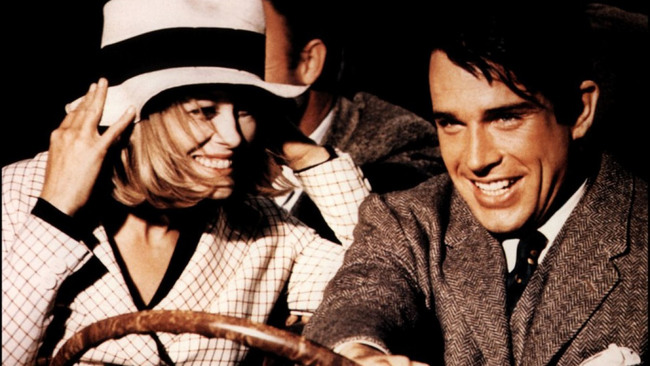Bonnie and Clyde at Fifty

Fifty years ago today, on August 13, 1967, Arthur Penn’s Bonnie and Clyde with Faye Dunaway and Warren Beatty opened in New York “at the Murray Hill and the Forum, on 47th Street and Broadway, right in the middle of the Summer of Love, a few weeks after riots leveled the ghettos of Detroit and Newark,” as Peter Biskind frames the event in Easy Riders, Raging Bulls.
“Much has been written over the past half century about how Bonnie and Clyde revolutionized Hollywood,” writes Entertainment Weekly’s Chris Nashawaty: “How it ushered in a revolutionary new sensibility when it came to subjects that were once considered taboo; how it spoke to a hipper, younger audience that had been largely ignored by the calcified, geriatric suits calling the shots up til then; how it was a game-changer that showed the way for an up-and-coming generation of New Hollywood directors more interested in anti-heroes than traditional heroes.” Nashawaty then delves into “not only how this sea change came to be, but also how divided the critical consensus on the film was at the time. It’s a revolution that almost never happened.”
For further reading, Nashawaty suggests that we “start with former EW editor Mark Harris’s 2008 book, Pictures at a Revolution.” And don’t stop there. All year long, Harris has been writing about golden anniversaries in a column for Film Comment, “Cinema ’67 Revisited.”
In 1967, “audiences and critics were drawn to the pop-Freud sexual tension between Bonnie and her ‘lover’ Clyde, who can't respond to her physically and experiences his only release when robbing banks and shooting guns, and to the bursts of graphic violence, which would be imitated in years to come, then one-upped, then made cartoonish,” writes Matt Zoller Seitz. On that same page at RogerEbert.com, you’ll find more reflections on the film from B. J. Bethel, Bob Calhoun, Sasha Kohan, and Brian Tallerico.
“The finale sees ambush, treachery and ugly people cutting the lovely couple to shreds,” David Thomson wrote in 2010. “Arthur Penn, one of the few artists in violence, designed the shoot-out in slow motion with multiple coverage building up to a shatteringly edited montage of destruction (Dede Allen did the editing). Notice how the lovers know they're going to get it just before the fusillade begins. There are ravishing cross-cut close-ups and an instant of intimate communion that will last to posterity.”
And now in the Guardian,Danny Leigh asks, “Fifty years after Faye Dunaway picked up her pearl-handled Smith and Wesson, does Hollywood need bringing back from the dead once more?”
As Yohana Desta points out with a sampler in Vanity Fair, critical response in 1967 was mixed. Flavorwire’s Jason Bailey focuses on a single review “that was, it could be argued, as revolutionary to the craft of film criticism as Bonnie and Clyde was to the craft of film. It was written by Pauline Kael, and it ran in the October 21, 1967 issue of the New Yorker.” And “it proposed a new way of looking at and thinking about movies, and a new way of writing about them.”
Olivia B. Waxman sketches a portrait of the original Bonnie and Clyde for Time. WNYC’s Sara Fishko has reposted her interview with Penn, who passed away in 2010 (7’14”).
And then there are the longish Sunday reads, Alan Vanneman’s 2004 piece for Bright Lights and Elaine Lennon’s for Senses of Cinema in 2006, “Riding the New Wave: The Case of Bonnie and Clyde.”
Fathom Events and TCM are putting Bonnie and Clyde back in select theaters today and Wednesday.
Updates: “It is one of the oldest American movies you can watch today without feeling like you’re watching an old movie,” writes Louis Menand for the New Yorker. “The screenwriters, Robert Benton and David Newman, were not Hollywood people—they had been magazine editors, at Esquire—and the director, Arthur Penn, the brother of the photographer Irving Penn, was an alumnus of Black Mountain College and a follower of the French New Wave. It was an unusual group of talent. . . . At the same time, it wasn’t an art film, like Jean-Luc Godard’s Breathless, which had been a big influence on Benton and Newman. It was entertainment, just entertainment for grownups.”
“The astonishing audacity of Bonnie and Clyde is that it revels in the forbidden sexiness of living beyond the law, of doing whatever you want from moment to moment, yet it never lets Bonnie and Clyde off the hook,” writes Variety’s Owen Gleiberman. “Bonnie and Clyde wasn’t conceived as a ‘counterculture’ movie, but it soon became one, because its unique fusion of violence and melancholy and exhilaration expressed, in every frame, the spirit that had been lying there like an unlit fuse since James Dean: the barely verbalized desire for something more.”
“Benton and Newman were explicit about the movie’s generational politics,” writes Jonathan Kirshner, adding that, “as Benton put it, ‘our sympathies are with Bonnie and Clyde.’ According to Newman, the tattoo of gang member C.W. Moss (Michael J. Pollard) was designed to underscore this generational theme. ‘Just as our parents were “offended” by long hair . . . rock and roll, smoking pot . . . we reflected this by inventing the tattoo on C.W.’s chest,’ he explained. ‘This is what offends his father, not that he broke the law.’ Because of that ‘and only that,’ Newman insisted, C.W.’s father ‘rats out’ Bonnie and Clyde.”
Update, 8/15: At Cinephilia & Beyond, you’ll find the screenplay and much more.
Update, 8/17: For the BFI, Samuel Wigley presents an annotated list, “One great New Hollywood film for every year (1967-82),” starting, of course, with Bonnie and Clyde.
For news and items of interest throughout the day, every day, follow @CriterionDaily.



